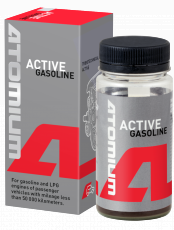Every day motorists visit our site with questions "my engine smokes, what is it?", "why does the engine smoke", "the engine smokes on cold, why?", etc., but, unfortunately very often we can't give a definite answer because:
Before giving recommendations about applying ATOMIUM it is necessary to understand properly the causes of the raised smokiness as the nature of its appearance is different and often is not connected with natural wear of the cylinder piston group. Structure of the smoke and its firmness doesn't give full information about the degree and the exact reason for the smoke; it will give a glue in what direction the troubleshooting will be aimed.
For a full assessment of the conditions an additional engine diagnostics are required as a rule.
We can divide the color of a smoke into three main colors: White, Blue, and Black which in turn can create a set of shades. So let's understand the nature of its origin.
Engine oil additive for restoring engine performance characteristics: compression, power, acceleration, effective fuel consumption, as well as for extending the wear life and protection in emergency situations. It will get rid of oil extra usage and engine smoke.
Engine smokes: the white smoke.

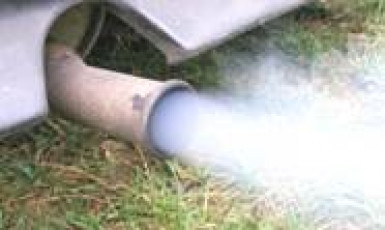
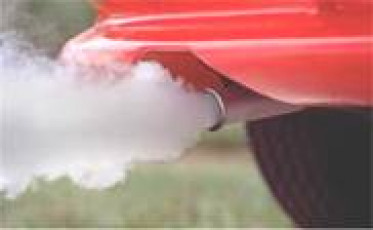
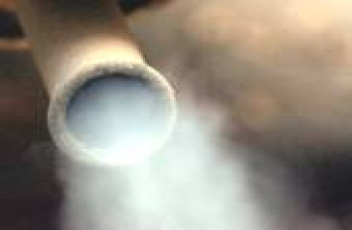
The White smoke comes out of an exhaust pipe - quite normal phenomenon when warming up of the cold engine. This is not smoke, it’s steam! Vapour is natural result of fuel combustion. While the exhaust system is still cold the vapour is partially condensed so it becomes visible, and on a cut of an exhaust pipe usually there is water. In the process of warming up the engine and the exhaust system condensation decreases. The colder the environment is the denser becomes the vapour. Vapour is formed at temperature below 10 C when the engine is well heated-up, but when it’s freezing at minus 20-25 C degrees the smoke becomes dense and white, with a gray shade. Color and a saturation of the smoke are also influenced by air humidity: the higher, the denser the vapour is.
If the vapour is visible even when it’s warm and on well heated-up engine, probably, it is an evidence of that the cooling fluid got in cylinders. The colour of the smoke depends on structure of a cooling fluid, weather, illumination and on quantity of cooling fluid in a combustion chamber. It can sometimes get a gray shade which looks like smoke from oil burning. But in difference from the oil smoke which leaves a bluish fog the vapour is quickly dissipated.
To the person without sufficient experience, it is difficult to determine by appearance what is actually the source smoke, therefore it is possible to use an "antiquated" way to check. On the well heated-up engine cover the cut of an exhaust pipe with a sheet of white paper, so that the condensed vapour in the form of water drops will appear on the paper. The drops will evaporate gradually without any oil spots. If this simple test confirmed that it’s the water vapour which comes out of the exhaust system not the oil smoke, so it is necessary to take measures for failure elimination when cooling fluid penetrates into cylinders.
Liquid can get to cylinders usually through the layer pad of the head of the block when it’s too loosen (during the winter period there is an evidence of leakage on the block and head joint), it can also happen due to the burnout or more rarely as a result of formation of microcracks in the head or on the cylinder block. Besides these defects cause penetration of exhaust gases in cooling system forming gas blocks which definitely proves failure.
Having opened a plug of a radiator or an expansion tank; it is easy to notice a smell of exhaust gases and an oil slick on a cooling fluid surface. And level of liquid will decrease. It is typical that in such cases after you start the cold engine pressure in the cooling system raises increasing cooling fluid level in an expansion tank. And this level is unstable and in the tank it is possible to notice bubbles of gas, sometimes with periodic blowout of some cooling fluid from the tank.
When you stop the engine the picture changes. Liquid starts getting into the cylinder. Gradually it passes through piston rings and gets to oil, into the crankcase of the oil pan. At your next start oil mixes up with the liquid, forming an emulsion and changes colour – gets a matte shade and becomes lighter. Circulating on the lubricating system, such emulsion leaves typical foam of light yellowy-brown color on a valve cap and a plug of the oil-filling mouth.
If the defect (the crack or the burnout) is insignificant, then the changes might not happen at all (it happens that oil remains pure though foam on the plug and valve cap is still formed). At very big damages liquid can collect over the bucket, interfere with rotation of a bent shaft by the starter at the moment of start. In especially bad cases the hydroblow in the cylinder, deformation and connecting rod breakage is possible.
In zones where the cooling liquid gets into the cylinder it the actively clears the deposit, so that it helps to define the location of the damage. For the detailed check you will need dismantle the head of the cylinder block, that allows to estimate the condition of the layer pad, the head and block planes.
It happens also that the cooling liquid gets to the cylinder through admission system - for example, because of leakage in the layer pad of an intake manifold (if it condenses also seals ports of heating up of a collector with a cooling liquid). In this case pressure of cooling doesn't raise in the system, there is no smell of exhaust, but there is a smell of emulsified oil, and coolant level rapidly decreases. These signs are usually enough to find the defect and not to confuse it with the above, otherwise it will be in vain to remove the head unit.
All the problems associated with white smoke from the exhaust pipe demand elimination of their direct causes, but also require to check the systems that can affect their appearance, the thermostat, the sensor switch, clutch or the fan itself, the condition of the radiator, its plugs, hoses or connections.
If the white smoke and the accompanying defects are observed, the vehicle cannot be used because the defects are progressing rapidly. But car owners often ignore this and don’t appreciate appearance of white smoke (steam) continuing to drive, but at this time the coolant is already doing its "dirty work", degrading the oil.
The formed emulsion causes increased wear not only of the cylinder group, but of all components and mechanisms, and ultimately leads to failure of the engine.
So how can ATOMIUM help in this situation?
Of course, ATOMIUM cannot prevent the occurrence of the above mentioned problems or eliminate them, and therefore cannot affect the amount of evaporation. But this is exactly the case when applying ATOMIUM products is more than justified, and here's why.
First the layer formed by ATOMIUM has higher toughness than the base metal, is able to resist the wear with a small leak of coolant. Second, having good oil-retaining capacity, the layer allows the engine to work trouble-free for a longer time even at large spills of coolant when the entire amount of oil is emulsified. Accordingly, this longer time will allow you to discover a problem, take action to prevent more serious consequences, and will save you from a more complex and costly repairs.
Engine smokes: The Black Smoke


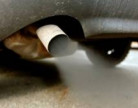

The black smokefrom the exhaust pipe indicates the fullness of the air-fuel mixture, and hence a fuel system fault. This smoke is usually clearly visible on a light background and is the soot particles - products of incomplete combustion.
The black smoke is accompanied by a high consumption of fuel, often a bad start, unstable operation of the engine, the high toxicity of exhaust gases, and often the loss of power due to sub-optimal air-fuel mixture.
In gasoline engines of black smoke is usually due to overflow in the float chamber needle valve due to a defect or due to coking of air jets.
In petrol engines with electronic fuel injection fullness of the mixture appears, usually shows the fault of sensors (oxygen, air flow, etc.), as well as leaking injectors. In diesel black smoke appears during disturbances in the high pressure pump, injectors, and at a high angle of injection.
As the operation of engines on overfilled mixture causes the increased formation of soot, it is reflected not only in the emissions. As a result, it is saturated with the engine oil, which later leads to rapid contamination of the motor, disturbance of the heat exchange; the coking is accelerated in the piston rings, and pollution of the oil filters and oil channels thus accelerating abrasion. Furthermore violation of the thermal state of the engine may cause burn-in of pistons or valves, which also causes even more serious consequences. Not burned completely fuel gets into the oil through the burnout in the piston and mixes with oil lowers its viscosity, which affects its anti-wear properties. It is obvious that driving with such defects is extremely dangerous, as quickly leads to new, far more serious trouble.
Why is it worth to apply ATOMIUM?
Now it is clear that, as in the first case, with white smoke if malfunction of fuel equipment of gasoline engines applying ATOMIUM in internal combustion engines cannot become a repair tool, but as a preventive measure the Lubricant is very effective firstly in order to reduce the impact of abrasive wear, and secondly sealing the gaps in the cylinder-piston group, it will reduce the possibility of breakthrough of the soot into the crankcase.
In case of failure of the fuel equipment of diesel engines, and which is usually a wear of a pair of plunger injection pump, ATOMIUM treatment of pumps through the fuel (ATOMIUM HPFP) would restore the quality of the fuel injection and combustion.
The second case of incomplete combustion of fuel is associated with the reduction of compression. That is the most typical for ATOMIUM treatment as the layer formed on the friction surfaces of the cylinder piston group recovers compression, and consequently improves the quality of combustion.
The black smoke disappears, engine power restores and fuel consumption oil waste reduce.
Engine smokes: Blue or dove-colored smoke


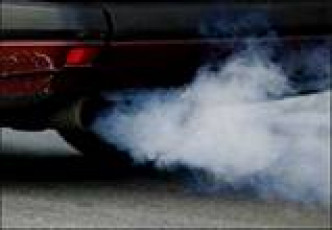

The mainreason for the appearanceof blue smoke - oil gets into the engine cylinders. "Oily" smoke may have blue color with various hues - from transparent blue to blue-white, depending on the engine operating condition, and the degree of the oil heating that got into the cylinders. In fact, the oily smoke, unlike steam, is not quickly dissipated to the air as mentioned above test paper shows oily spots emitted from the tube together with the exhaust gases.
The oily smoke is associated with increased consumption of oil. On the transient oil smoke becomes thick. Owners of modern cars have to remember about the converter, that cleans exhaust gases from the oil even at a sufficiently high consumption.
Oil can get to the combustion chamber through the enlarged gap in the piston rings, or through the gap between the valve stems and guides.
Wear of the cylinder group - one of the most common causes for oily smoke. Wear is possible in cylinder liners, rings, and in piston ring groove. Furthermore large gaps in the grooves create pumping effect, pumping oil into the combustion chamber, even if the scraper rings are normal, oil can get into the cylinders.
The deviation of the cylinder form from the circumference worsens sealing properties. In the area of locks lumens are formed, but their occurrence is not excluded in other regions of the circumference.
Wear of the cylinder group is often accompanied by loss of compression and increasing the pressure of crankcase gases. However, be aware that it is often a large amount of oil entering the cylinders tight on the gaps in the adjacent parts and the evaluation result of compression can be quite normal, sometimes even closer to the upper limit. It is this fact confuses appearance of blue oily smoke.
The considered above defects usually do not occur in all the cylinders at once. It is easy to find the faulty cylinder by comparing the condition of the spark plugs and the compression in different cylinders. Moreover, these defects are often accompanied by all sorts of noises and knocks that change with turns, the load and the degree of warming up the engine, and the unstable operation of the engine due to power cylinders (especially at cold start).
Common group of faults, that cause oily smoke and increased oil waste is connected with deterioration of valve systems and guides, as well as with the wear, mechanical defects and aging of stem seals (loss of elasticity). These defects tend to give a significant increase of engine smoke during warming, because liquefied hot oil can much easier pass through the gaps between the worn parts. In addition, the oil entering the cylinder is amplified at idle and when use engine braking. In these modes, the intake manifold produces a large vacuum and the oil flows through the valve stem under the influence of pressure difference, accumulating on the walls and parts of the exhaust system. Subsequent opening of the throttle for the first time dramatically increases the density of blue oil smoke.
In turbocharged engines oil consumption followed by blue smoke is possible due to a malfunction of the turbocharger, in particular, the wear of the bearings and seals of the rotor. Seal wear of the front bearing of the compressor gives a picture similar to the failure of the valve stem seals (including the oil fouling on the plugs), but in the inlet side of the compressor a pool of oil appears.
Fault seal turbine is difficult to determine, because the oil is delivered directly into the exhaust system and it burns there.
During operation the blue smoke and increased oil consumption often appear if you disable one of the cylinders due to faulty ignition or in the absence of valve tightness. In the latter case, the smoke becomes white and blue, especially if the valve has a clear burnout. Such a defect is determined without difficulty - compression in this cylinder is negligible or non-existent, and a plentiful black deposit appears on the candle, often in the form of nodules.
There are also some exotic defects that cause blue oil smoke. So on vehicles equipped with automatic transmissions with a vacuum load cell membrane regulator disruption is possible. Since its cavity is connected by a hose to the intake manifold, the engine begins to simply suck the oil from the gearbox. Typically, oil is supplied only to those cylinders around which a selection is made of the vacuum manifold. So candles can be thrown and oil splashes can get out of the plug hole.
Effect of ATOMIUM application
Finally we come to the end of the third section, and with full confidence we can say that in most cases the presence of blue smoke ATOMIUM can be applied not only for prevention, but also as effective means of repair and rehabilitation. Since the cause of blue smoke more is often wear in the pair of friction, which has all the necessary conditions for the effective applying of ATOMIUM lubricants. When applying ATOMIUM products in these conditions it is possible not only to get rid of the smoke, as well as the causes of its occurrence, improving the condition of worn components. Preventive measures of ATOMIUM in all three cases will save you from more serious problems and unexpected expenses.

